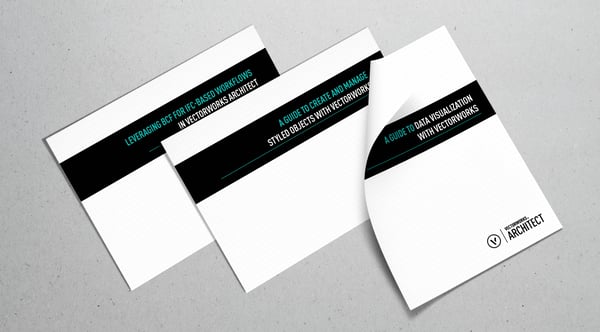We’re bringing you some of our newest ebooks that are sure to help you master Vectorworks features.
Straight from the minds of our in-house product experts, these workflow documents each take one feature and deconstruct it down to its basics — that way, you have everything you need to fully understand them and use them in your own design work.
This post will cover the following:
- Data Visualization
- Creating and managing styled objects
- Leveraging BCF for IFC-based workflows

Let’s start with a look at data visualization.
What is data visualization?
Data visualization, at its core, is assigning visual attributes that represent specific data to objects in a model. In simpler terms, it’s a way to view data right in the design layer.
One way to use
data visualization — and you can find an example of this in the document — is to add color to objects indicating their compliance with code requirements. The ebook shows a modeled building with its doors and walls marked for compliance with fire code standards.
Data visualization capabilities have existed for a long time in Vectorworks. With version 2020, now it's more streamlined — with one Data Visualization menu, all of the capabilities live in one place, making it all around easier to use.
GET THE GUIDE
Next up is your comprehensive resource for creating and managing styled objects.
What are styled objects?
Think of styled objects as custom resources that you can place into your designs at will. If your firm loves using one particular style of window, for example, you can save it in the Resource Manager for future use.
Explore this Getting Started Guide for video tutorials on maximizing your use of the Resource Manager.
Styled objects are powerful once you master them. With a library of styled objects, you can really give your firm an identity in your designs by using the same objects repeatedly. Not only that, but it provides greater control and consistency in reporting and documenting of your projects.
GET THE GUIDE
The last document we’ll talk about concerns BCF.
What is BCF?
The BIM Collaboration Format (BCF) is an Open BIM workflow that comes from
buildingSMART International. The intent is to allow users to leverage BIM data across a wide range of software options and workflows.
In simple terms,
BCF works by transferring information about an issue or problem from one application to another while directly referencing a view and elements of a building information model. Like
IFC, BCF removes proprietary technology barriers and puts the focus on the user’s knowledge and data, not the platforms they use to capture it.
Something awesome about BCF is it supports roundtripping, meaning teams can mark up one singular document and share with collaborators. It’s a completely multidirectional workflow. You’ll find an extensive example of how to use it in the ebook.
GET THE GUIDE
 Let’s start with a look at data visualization.
Let’s start with a look at data visualization.

 Let’s start with a look at data visualization.
Let’s start with a look at data visualization.